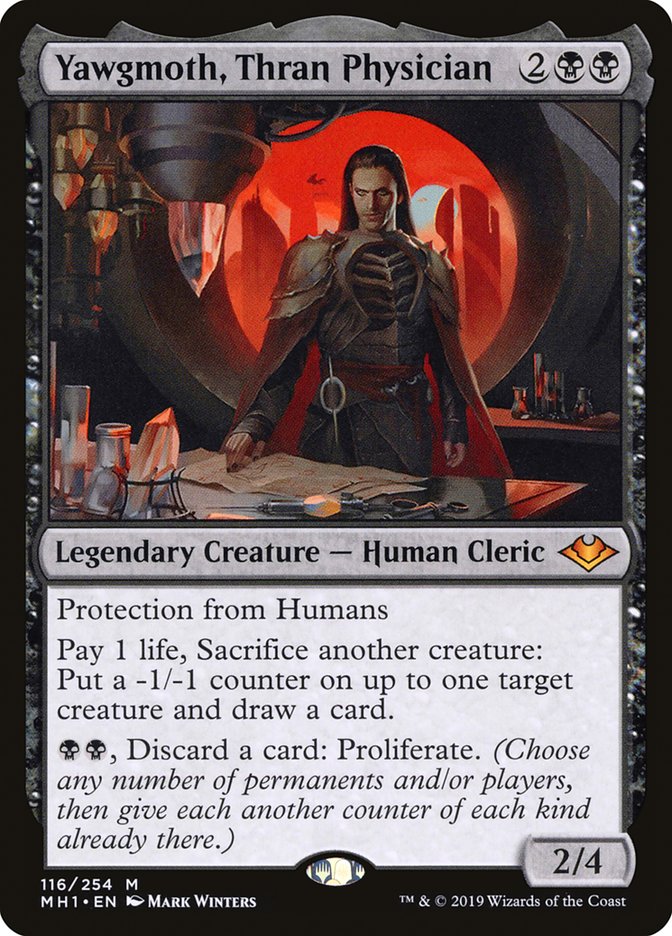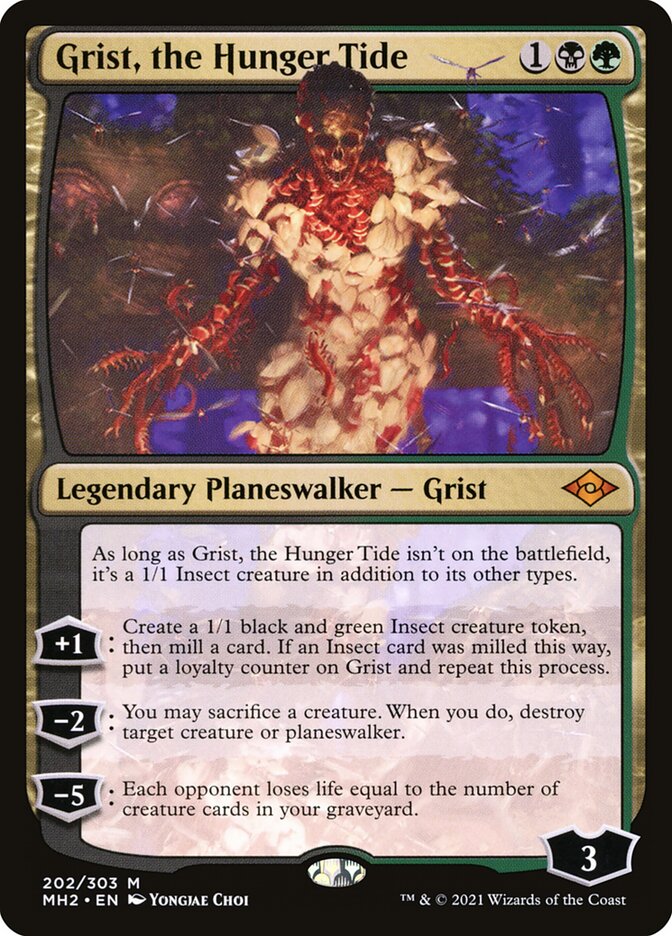Welcome to MTG Meta Breakers! This series is devoted to helping you take on some of the most common decks in your favorite formats (aka “the meta”).
Whether you’re looking to grind competitive events on MTGO, want to win your local Friday Night Magic (FNM), or are just sick of getting beat, you’re in the right place.
For the purposes of this series, we’ll assume that all games are in best-of-three format. This allows you to sideboard against your opponent. When hoping to take down the metagame, sideboarding is your best friend.
Without further delay, let’s dive in!
Yawgmoth is a popular creature-based combo deck in Modern. It’s powerful, resilient, and can fight through hate to win the fair game. How can you beat it? Let’s explore the deck and its cards to understand how it wins first.
Understanding Yawgmoth Decks in Modern
Yawgmoth has risen in popularity, thanks in no small part to some recent additions like Agatha’s Soul Cauldron. The deck still revolves around its namesake card, Yawgmoth, Thran Physician, and includes several ways to tutor it in addition to the four copies already in the deck. Yawgmoth is a powerful card advantage engine that can also control the board when used with undying creatures and combo kill the opponent as well.
Those undying creatures are Young Wolf and Strangleroot Geist. Aside from being great sacrifice fodder and part of the combo kill, they can also attack for big chunks of damage and are tough to get rid of on their own.
Yawgmoth plays around ten mana creatures, usually some combination of Delighted Halfling, Ignoble Hierarch, and Wall of Roots. These help ramp into bigger creatures and Chord of Calling. Notably, traditional mana dorks with one toughness have fallen out of favor recently due to the prevalence of Orcish Bowmasters. So expect to see more mana creatures with two or more toughness.
Speaking of, Yawgmoth decks also usually play the full four copies of Orcish Bowmasters. Two bodies for two mana at instant speed fits right in with the game plan. Grist, the Hunger Tide ties everything together, creating an insect every turn and killing any problematic creatures. Its ultimate can also help win if the game has taken a more aggressive route.

The big new addition to the deck is Agatha’s Soul Cauldron, and it looks like it’s here to stay. The best-case scenario is usually exiling a Grist from the graveyard to give all your creatures with +1/+1 counters the planeswalker’s abilities, which lets you quickly fill the board with tokens or deal with your opponent’s creatures. The Cauldron also lets you combo faster and access more powerful lines while also providing more interaction and an alternate kill when it exiles a Walking Ballista.
The general plan of Yawgmoth is to fill the board with small creatures while searching for a way to get Yawgmoth on the board. From there, Yawgmoth can sacrifice creatures to mow down the opponent’s board and refill your hand. The most common way to win has been using Yawgmoth with two undying creatures to combo. If one undying creature has a +1/+1 counter, Yawgmoth can sacrifice the other one to put a -1/-1 counter on the first. This takes the counter off while triggering undying to put a +1/+1 counter on the second creature. This repeats for every 1 life paid, and with a few extra creatures it becomes trivial to find a Chord of Calling or Eldritch Evolution to cast that turn for a Blood Artist. You can then keep the loop going while gaining life to offset Yawgmoth’s activated ability and drain your opponent to zero.

Yawgmoth’s Threats
Yawgmoth, Thran Physician is the single card that the deck revolves around, and can win the turn it comes into play. It has two very powerful activated abilities, although the first one is used the most. By paying one life and sacrificing a creature, Yawgmoth puts a -1/-1 counter on another creature and draws a card. The mass of extra creatures from Orcish Bowmasters and Grist are perfect sacrifice fodder, not to mention the undying creatures that can reset each other and draw too many cards to count.

Grist, the Hunger Tide is a huge problem for other creature decks, constantly adding tokens to the board and threatening to kill anything relevant. As mentioned before, its ultimate ability finishes off opponents after a fast start and can go off as soon as the third turn in play. It’s also a creature, which means Eldritch Evolution and Chord of Calling can pull it from the deck and Spell Pierce can’t address it on the stack.
Agatha’s Soul Cauldron can be a big problem as well, especially paired with a Grist to exile from the graveyard. Even without creatures with activated abilities to exile, the floor is an extra +1/+1 counter every turn, and even one Delighted Halfling or Wall of Roots can provide a huge mana advantage.
Many lists are now playing Walking Ballista, which can be an effective mana sink if drawn. When it gets exiled with the Cauldron, however, it turns every undying creature into an infinite damage combo win with a sacrifice outlet or Blood Artist on the field.
Interaction
One weakness of the deck is its abundance of creatures and lack of instant speed removal, aside from Yawgmoth’s activated abilities. The sideboard has more interaction, but in general, Yawgmoth has trouble with big creatures and planeswalkers if it doesn’t find a Grist.
Orcish Bowmasters, Endurance, and Chord of Calling are usually the only spells Yawgmoth can cast at instant speed in game one, so be careful when attacking into open mana or multiple untapped creatures.
Modern Yawgmoth Sideboard Options
Fatal Push and Pile On are the go-to removal spells since they’re cheap enough to fit in with casting creatures every turn. Force of Vigor and Haywire Mite attack artifacts and enchantments, and Endurance comes in for opposing graveyard strategies. Necromentia and Thoughtseize can come in against combo and control decks, and Chalice of the Void against cascade decks like Living End and Rhinos. Elven Chorus is seeing more play as a great card advantage engine in grindier matchups, especially against decks that might have a tough time answering an enchantment like Rakdos Scam.
One thing to remember is that Yawgmoth can always find a “silver bullet” creature thanks to Chord of Calling and Eldritch Evolution.
Cards That Beat Yawgmoth in Modern
Without its namesake card, Yawgmoth turns into a mediocre creature deck. It’s still full of value and can win through combat, but is much more beatable without the threat of a combo kill. But remember, a Yawgmoth in the graveyard is just as threatening since a Soul Cauldron lets them turn on their combo once again.

If you have access to Pithing Needle, it should come out and name Yawgmoth as soon as possible. Yawgmoth can win the game the turn it comes into play, so don’t give your opponent a chance if possible. If you have access to multiple Needle effects in a game, consider whether you need to name Grist or Soul Cauldron. The right answer likely depends on the game state and what your plan of attack is. Also remember, naming Yawgmoth does not stop a creature from using its ability via Soul Cauldron.

Graveyard hate is very effective in this matchup, shutting off undying creatures from coming back and rendering Agatha’s Soul Cauldron almost useless, assuming it hasn’t already exiled a creature. The combo kill gets shut off, but Yawgmoth itself can still draw cards and look for an answer. Grafdigger’s Cage is particularly effective, since it also stops Eldritch Evolution and Chord of Calling, but does allow the Cauldron to still work. Cards like Leyline of the Void which offer passive, permanent graveyard exile are at a premium here compared to one-time graveyard hate like Relic of Progenitus or Soul-Guide Lantern.

An early Fury taking out multiple mana creatures is a great way to buy time and slow down Yawgmoth or prevent a big Chord of Calling.
Supreme Verdict can help as a reset button against a board full of creatures, although Young Wolf and Strangleroot Geist might stick around. Dress Down can take away the undying ability, and can also buy time against early mana creatures.
Any removal that exiles is extremely valuable in this matchup, thanks to the Cauldron exiling creatures from the graveyard and undying creatures coming back after dying. Prismatic Ending, March of Otherworldly Light, and Solitude are great choices.
Tips and Common Mistakes Against Yawgmoth in Modern
Don’t think that one Needle or Leyline of the Void locks up the game. Yawgmoth players have access to multiple copies of Boseiju, Who Endures and Force of Vigor in the sideboard alongside Haywire Mite (which they can tutor for). They can also play an aggressive game if needed, ignoring their graveyard entirely.
Agatha’s Soul Cauldron can exile cards from both graveyards, and not just creatures. In a pinch, it can shrink your Dragon’s Rage Channeler or take out a flashback spell or reanimation target. Be careful if you play creatures with activated abilities as well.
Yawgmoth’s Proliferate ability is rarely used, but watch out if your opponent has two mana available and counters are everywhere. If a Cauldron is out, any kind of mana can be used for that ability as well. Your opponent proliferating -1/-1 counters on your creatures, Burden counters on your One Ring, or Loyalty counters on Grist are a few common occurrences.
Like most black decks, Orcish Bowmasters is always a threat with two mana open. Be careful with one-toughness creatures and drawing extra cards. On the other side, flashing in a Bowmasters can let you ping for extra damage when the Yawgmoth player is drawing extra cards. Just remember, they can give your Bowmasters a -1/-1 counter at instant speed to kill it.
Timing your removal and being patient is important. It’s usually correct to kill the deck’s first mana creature on the first turn or two if possible, but so many of the smaller creatures are interchangeable and end up being fodder for Yawgmoth. Any sorcery speed removal should probably be used quickly since a Yawgmoth can take over or win at instant speed.
Best Matchups Against Yawgmoth in Modern
Tron is one of Yawgmoth’s worst matchups. It can quickly take over the game with a huge mana advantage, and find quick answers to individual threats. Yawgmoth doesn’t have a great way to interact either, with only a few copies of Boseiju, Who Endures. Karn, the Great Creator prevents Agatha’s Soul Cauldron from activating, and gives access to Pithing Needle, Grafdigger’s Cage, or Tormod’s Crypt even in game one.
Another big mana deck that has a good Yawgmoth matchup is Amulet Titan. Yawgmoth doesn’t play many ways to kill big creatures, so if a Primeval Titan resolves, it’s usually game over. Dryad of the Ilysian Grove has four toughness, and Titan as a deck is usually a turn or two faster at setting up a combo kill, especially with so few roadblocks.
Combo decks that don’t rely on creatures are favored against Yawgmoth, such as Belcher or Oops All Spells. They can usually power through the small amount of hand disruption and win faster than the creature combo can come online.
Conclusion
Yawgmoth is undoubtedly a powerful combo deck with a strong creature backup plan, but it’s not unbeatable. Focus on taking out mana sources early and not letting Yawgmoth itself take over the game, and you’ll stand a chance.


 Support us on
Support us on 


